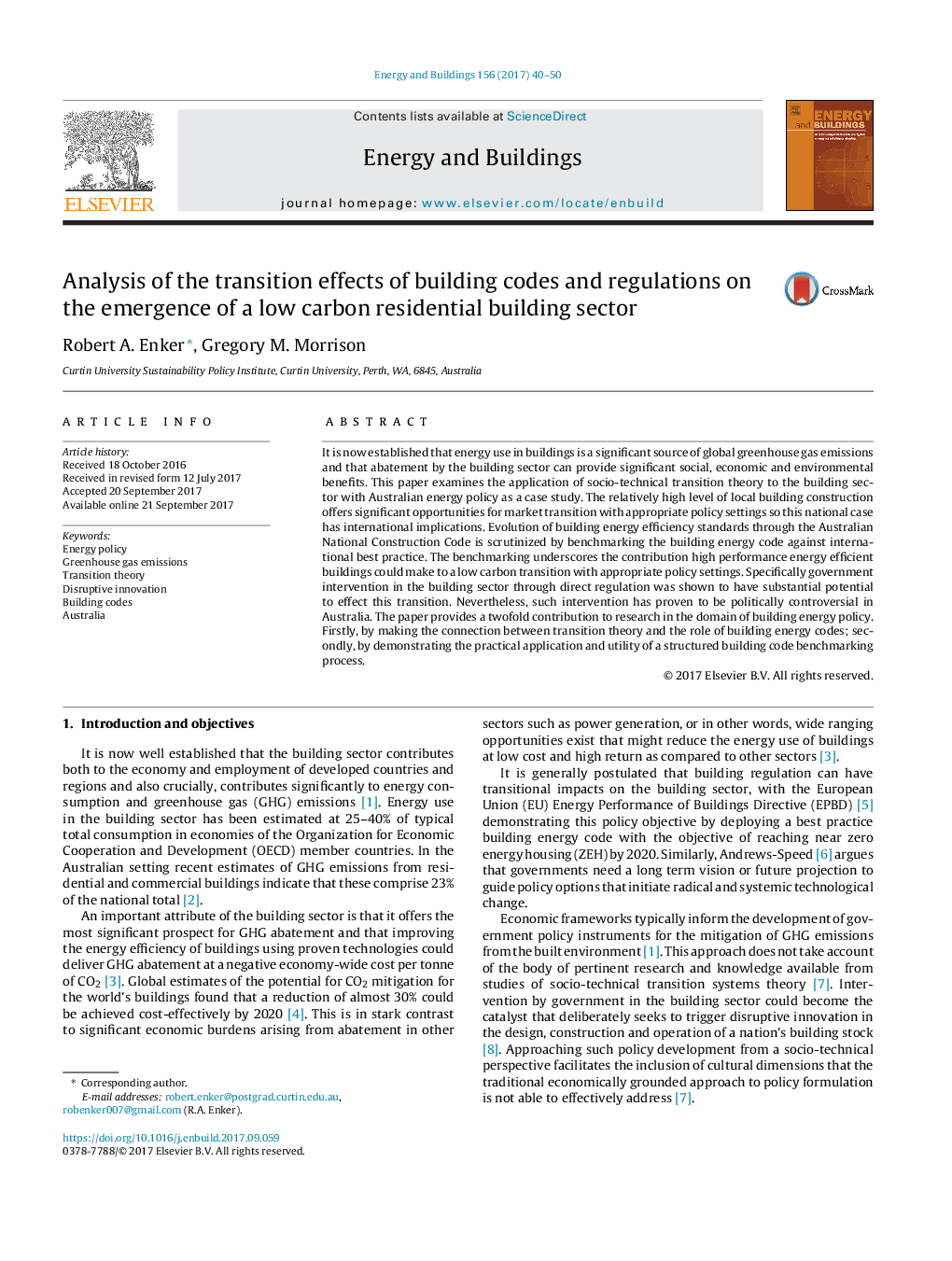| کد مقاله | کد نشریه | سال انتشار | مقاله انگلیسی | نسخه تمام متن |
|---|---|---|---|---|
| 4918799 | 1428934 | 2017 | 11 صفحه PDF | دانلود رایگان |
عنوان انگلیسی مقاله ISI
Analysis of the transition effects of building codes and regulations on the emergence of a low carbon residential building sector
ترجمه فارسی عنوان
تجزیه و تحلیل اثر گذار از کدهای ساختمان و مقررات در ظهور یک بخش ساختمان مسکونی کم کربن
دانلود مقاله + سفارش ترجمه
دانلود مقاله ISI انگلیسی
رایگان برای ایرانیان
کلمات کلیدی
سیاست انرژی، انتشار گازهای گلخانه ای، نظریه انتقال، نوآوری مخرب، کدهای ساختمان، استرالیا،
ترجمه چکیده
در حال حاضر تاسیس شده است که مصرف انرژی در ساختمان ها منبع مهمی از انتشار جهانی گازهای گلخانه ای است و کاهش آن توسط بخش ساختمان می تواند منافع اجتماعی، اقتصادی و محیط زیستی را به همراه داشته باشد. در این مقاله، کاربرد تئوری انتقال اجتماعی-فنی به بخش ساختمان با سیاست انرژی استرالیا به عنوان یک مورد مورد بررسی قرار گرفته است. سطح نسبتا بالایی از ساخت و سازهای محلی فرصت های قابل توجهی برای انتقال بازار با تنظیمات سیاست مناسب فراهم می کند تا این پرونده ملی دارای پیامدهای بین المللی باشد. تکامل استانداردهای بهره وری انرژی از طریق قانون ساخت و ساز ملی استرالیا با بررسی معیار انرژی ساختمان در برابر بهترین روش بین المللی بررسی می شود. معیار سنجش نشان می دهد که سهم بالای ساختمان های کارآمد انرژی می تواند به یک انتقال کربن کم با تنظیمات سیاست مناسب منجر شود. به طور خاص مداخله دولت در بخش ساختمان از طریق نظارت مستقیم نشان داد که پتانسیل قابل توجهی برای تأثیر این انتقال دارد. با این وجود، چنین مداخلات در استرالیا به لحاظ سیاسی بحث انگیز است. این مقاله سهم دوگانه در تحقیق در حوزه سیاست انرژی ساختمان را فراهم می کند. اولا، با ایجاد ارتباط بین تئوری انتقال و نقش کدهای انرژی ساختمان، ثانیا، با نشان دادن کاربرد عملی و کاربرد یک فرایند ارزیابی استانداردهای ساختمان ساختار یافته.
موضوعات مرتبط
مهندسی و علوم پایه
مهندسی انرژی
انرژی های تجدید پذیر، توسعه پایدار و محیط زیست
چکیده انگلیسی
It is now established that energy use in buildings is a significant source of global greenhouse gas emissions and that abatement by the building sector can provide significant social, economic and environmental benefits. This paper examines the application of socio-technical transition theory to the building sector with Australian energy policy as a case study. The relatively high level of local building construction offers significant opportunities for market transition with appropriate policy settings so this national case has international implications. Evolution of building energy efficiency standards through the Australian National Construction Code is scrutinized by benchmarking the building energy code against international best practice. The benchmarking underscores the contribution high performance energy efficient buildings could make to a low carbon transition with appropriate policy settings. Specifically government intervention in the building sector through direct regulation was shown to have substantial potential to effect this transition. Nevertheless, such intervention has proven to be politically controversial in Australia. The paper provides a twofold contribution to research in the domain of building energy policy. Firstly, by making the connection between transition theory and the role of building energy codes; secondly, by demonstrating the practical application and utility of a structured building code benchmarking process.
ناشر
Database: Elsevier - ScienceDirect (ساینس دایرکت)
Journal: Energy and Buildings - Volume 156, 1 December 2017, Pages 40-50
Journal: Energy and Buildings - Volume 156, 1 December 2017, Pages 40-50
نویسندگان
Robert A. Enker, Gregory M. Morrison,
